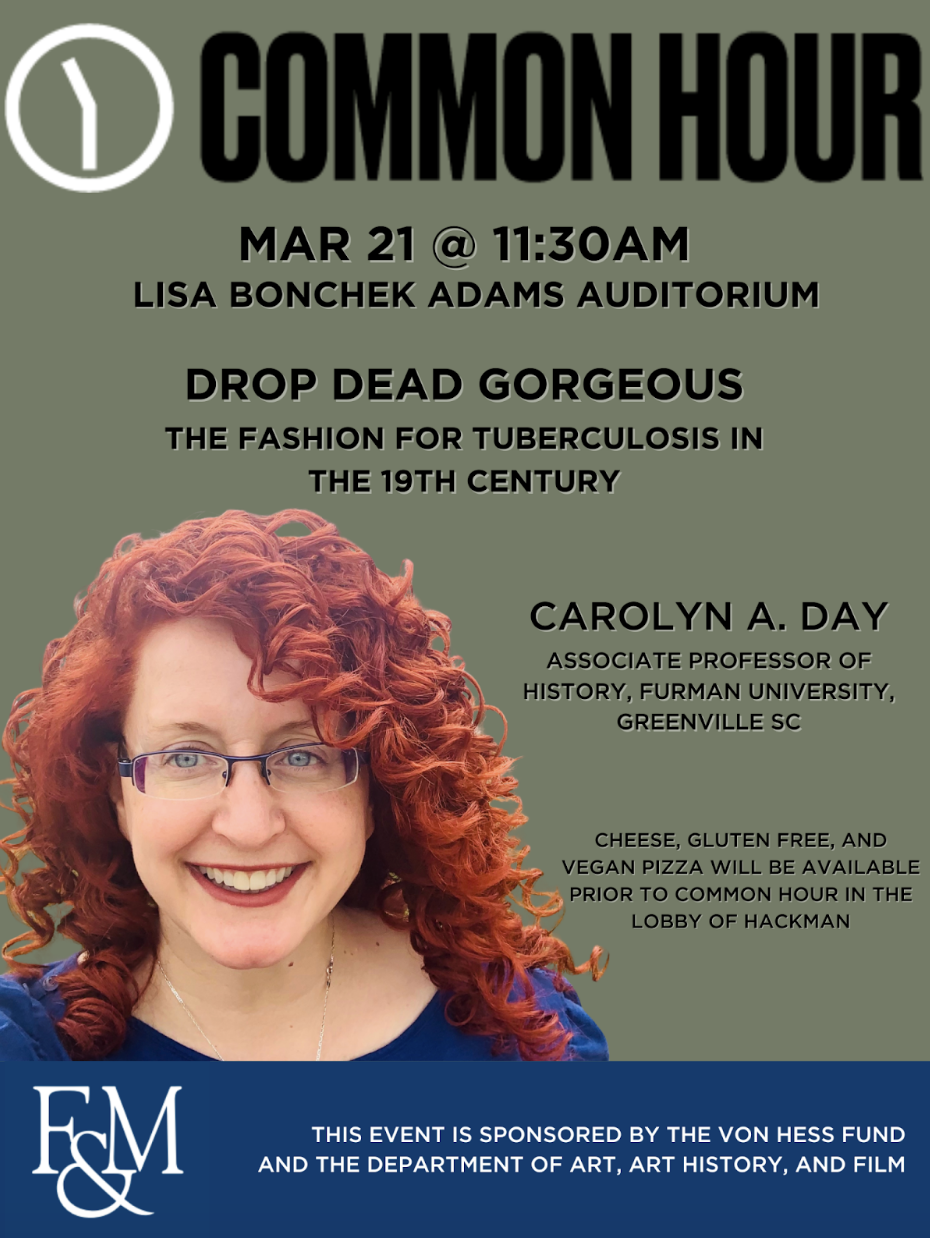Photo courtesy of Franklin & Marshall College
Drop.
Dead.
Gorgeous.
Hosted on March 21st in the Lisa Bonchek Adams Auditorium, this Common Hour, titled Drop Dead Gorgeous: The Fashion for Tuberculosis in the 19th Century, welcomed Carolyn A. Day, an associate professor of History at Furman University to present a lecture on this fashionably morbid topic.
Combining interdisciplinary interests, Day pursued a double major in molecular biology and history, and has utilized this broad understanding to decode some of the bizarre, worrying, and outright dangerous fashion practices.
For example, consumption. As this medical concern left its English patients with large dilated eyes, flushed, a thin torso, and nearly translucent and pale, women sought to beautify themselves through the destruction of their health. As beauty was, and still is with such concepts as ‘pretty privilege,’ considered an outward validation of good character and desirability, sacrificing one’s health was considered a small price to pay.
A small price, perhaps to any outward viewer. However, it was a deadly endeavor for its practitioners.
Dr. Day opened her talk by explaining her interest: describing herself as ‘a former microbiologist,’ she relayed her confusion when she started hearing that tuberculosis (TB) was a ‘beautiful’ disease to have. Warning, this is a little gross, but the typical symptoms are wasting / emaciation, relentless diarrhea, fever / night sweats, and violent coughing of blood and phlegm. So how was the disease ever considered beautiful?
The short answer is societal prioritization. The connection between disease and aesthetics was visible and pervasive in society. It became trendy to be prettier than you are healthy. In time, beauty standards came to align with the symptoms of TB. The disease exacerbated qualities that were already seen to be attractive – pale, thin, delicate, pink cheeks, curved wing-backed appearance, large dilated eyes, and visible blue veins.But it wasn’t just the association of looking sickly with looking pretty, it’s the fact that being pretty was believed to be what makes you more likely to get TB.
These ideas were so ingrained into society that they came to be backed up by medical professionals. Symptoms were seen as predispositions. And like many issues of the time, the ways TB impacted men vs women was drastically different. Death by TB was described in vastly inconsistent terms, in a man as “despair in every shape” and in women as “a grace and a beauty that surpassed her living days… a countenance that painters and sculptors cannot reach… she took leave of us all with tenderness unbounded.”
It wasn’t just the symptoms of the disease and descriptions of death from it that differed in men and women. Society being society, there were some other negative impacts just for women. Doctors tied TB symptoms to beauty, then into moral standing, as it came to be believed that the blushing of TB was thought to be an indication of women’s sensibilities. For those who didn’t have TB, it became trendy to use cosmetics, in some cases literal small-dose poison, and corsets to mimic the physical symptoms of TB.
Beyond the tangible negative side effects of wearing corsets designed to make you look emaciated, the trend of using cosmetics to mimic the symptoms resulten in men / society villifying cosmetics. Ever heard of take her swimming on the first date? Due to the substances used in cosmetics at the time used to make faces very pale being sulphur reactant, a trend started in London to take dates on a walk past a fountain that omitted sulpherious gasses, judging the women whose face makeup changed color.
And remember how TB symptoms were now tied to moral standing for women? You guessed it – if a woman was shown to have had makeup on she was then seen as being morally corrupt. This elevates beauty as something natural to women of virtue. TB became a way of achieving virtuous character and physical attractiveness – consumptive chic was the new trend.
In time, this idea spread from face makeup into corsets, in a style called sympathetic dress. Even as corsets were accused of causing the disease, they were praised for making women look beautiful – for making them look like they had TB. If you had it you were beautiful, and were dying, if you didn’t have TB and wore corsets to look like you did, you’d get it. There was no winning for women.
So how did such a pervasive idea change? Once again, the answer is societal prioritization. A very popular book called La Dame aux Camellias pushed idea that sex workers had caught onto the trend of the having-TB-is-pretty agenda – and as TB was suddenly no longer tied to respectability / virtue, consumptive ideology lost its sway in England. Demotion of TB from the ranks of respectability means that healthy fashion could rise.
All told, the fascinating rise, reign, and fall of consumptive chic lasted about 60 years. If you loved learning how this association developed, consider going to more Common Hours! Future Common Hours promise similarly interesting topics, such as an upcoming one on book bans and censorship! There will also be pizza, with cheese, gluten free, and vegan options available and plentiful. Thank you so much to Dr. Carolyn Day for this spectacular look into consumptive chic!
Sophomore Teagan Durkin is the Opinions Editor. Her email is tdurkin@fandm.edu. Junior Ella Peeples is Managing Editor. Her email is epeeples@fandm.edu.
